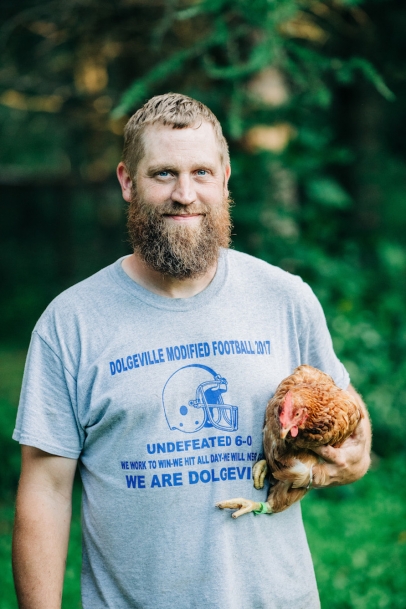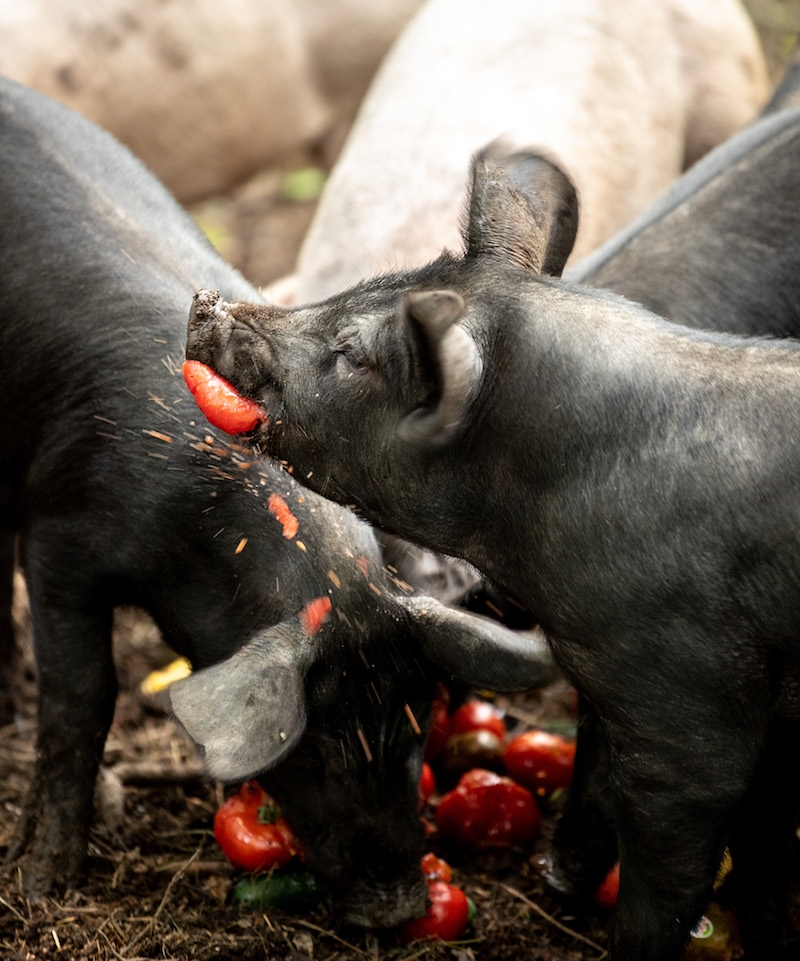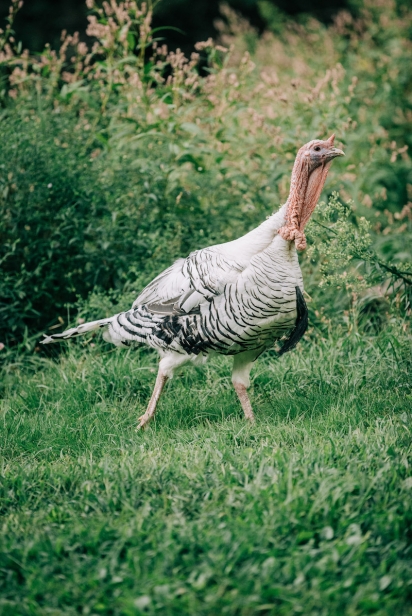Fictitous Farm
There’s a reason Big Ag farm operations are primarily built on flat, prairie-like land. Companies seeking cheap, easy to replicate, consistent products are going to make their work as uncomplicated and predictable as possible.
Mountain farms are perilous, mercurial beasts; the terrain is challenging, the climate less predictable, the growing season shorter, the labor costs higher.
But as with many difficult things, the payoff comes at the end of the day. (Think: bright-orange egg yolks, lush and buttery bacon, deeply flavored and tender steaks.)
“I’m in the Adirondacks, and I became a farmer because I love the outdoors, I love animals, and I love working with my hands,” Scott Seeley explains. “I’d never even consider doing a giant clear-cut of the forest on our land, because while it might make things easier in some ways, the long-term consequences for the land and the animals would be negative.”
Seeley founded the 85-acre Fictitious Farm, in Stratford, four years ago. He and his wife, Amy, who works as a registered nurse, their children, Katelyn, 12, and Hayden, 13, all work together on the farm build-out when they can, but day to day, Seeley is the sole farmer, architect, construction worker, animal caretaker, mechanic, fencemender and poop picker-upper on the farm. He studied wildlife biology as an undergraduate in Montana and, before graduating, returned to Johnstown where he grew up. He worked as a mechanic for 15 years, and he’s thrilled to be able to finally deploy all of the skills he picked up along the way (and then some).
“Amy and I always knew that eventually I’d start a farm, but it was just a matter of money and timing,” Seeley says, adding that they never borrowed a dime and are self-funding the entire operation.
“Yep, it’s on a shoestring as you can imagine, but I went to meet with a bank and I realized very quickly that they would want to micromanage every aspect of the operation, from the type of farming I did, to how and where I built our barn, and I was not comfortable with that,” he recalls.
There are cows, chickens, turkeys and pigs on Fictitious Farm, and it is in a state of constant, DIY, elbow-greased construction, Seeley explains. Plans change faster than a bureaucratic lending operation can deal with, he adds.
“Because we’re in the Adirondacks, there is forestland on our property, and I didn’t want to clear it because I want the farm to be as sustainable as possible and coexist with the wildlife,” Seeley says. “But we did have to clear some trees to create pasture for cows.
We’re repurposing that wood in a barn I’m in the middle of building. We also chipped some wood and most of the branches to use for composting and bedding for the chickens and pigs.”
He has tweaked several operations already, after quickly learning that his initial notion wouldn’t fly. Take the chickens.
“I wanted the chickens to be completely free-range, without any fencing of any kind,” Seeley says. “But I quickly discovered that they can get hypothermia even in relatively warm weather if there’s a serious downpour, and they became easy prey to the coyotes and other predators.”
So Seeley created a mobile free-range 8- by 10-foot zone for the chickens that the Seeleys move around the farm so the birds can have fresh wind and sun to feel, and grass and bugs to eat but also remain safe and protected. The chickens, along with the pigs, turkeys and cows at Fictitious, have pastured diets supplemented with GMO-free grains; and while many of his practices are organic, the farm is not certified organic.
Seeley also had to adjust his approach to raising hogs last year.
“We started out with industry-standard production pigs,” Seeley says. “But they couldn’t really hack the winters here. They really struggled.”
This winter, the porkers will be Berkshires.
And they will be able to withstand Seeley’s newfangled take on old-fashioned Adirondack farming practices: silvopasture. Farmers in mountainous terrains all over the world have for centuries depended on silvopasture, which involves the deliberate integration of trees into grazing livestock operations.
In silvopasture programs, grazing livestock dine on not just native pasture grasses but also the vegetative plant growth among the trees. The practice, according to the National Agroforestry Center of the U.S. Department of Agriculture, helps keep soil healthy, prevents pasture erosion and provides cooler conditions for animals in the summer and protection from extreme wind and cold weather in the winter. It also, essentially, provides the animals with a more diverse and nutrient-rich diet, which translates into #goodeats for you and me.
The pigs love running through the trees, grazing in the fields, lazing around and just getting jiggy with their piggy selves. Seeley admits that even now, he’s sometimes surprised by what they dig up.
“I turned around the other day and the pigs had dug a hole in the ground the size of a Volvo. They were just eating dirt. Who knows why? The minerals? People always ask me why our meat is tastier than the stuff they get at the grocery store, and I don’t have a scientifically sound answer for them,” Seeley admits. “I just know there’s something in keeping animals outside in the sun, letting them fi nd their own food, that makes for happier animals and a tastier product.”
Making Fictitious Farm a reality has clearly required not just the classic farming “use what you’ve got” full-circle mentality but seriously creative thinking. For example, instead of hiring a builder to create a barn, Seeley bought a kit with hardware and the design for a heritage-style barn from an architect in Michigan, so he can build it himself, with wood from his farm. Instead of spending about $100,000, he’ll end up spending about $40,000.
Seeley also dons his creative accountant hat when designing options for customers.
“We started a chicken CSA this year, and I’m working on getting a permit to serve precooked chicken at the Spa City Farmers’ Market,” he says. “Next year, we may do a meat box CSA.” Seeley knows eaters love a good bargain as much as they love #goodeats, so he sows price-breaks into bulk buys. Customers who signed up for his chicken-a-week CSA for the summer, for example, got a free turkey just in time for Thanksgiving.
A (free!) pasture-raised heritage-bred turkey bought from a family- run mountain farm? That’s a delicious deal we can all be thankful for.
FICTITIOUS FARM BY THE NUMBERS
Egg-laying chickens 200
Meat chickens 600
Turkeys 125
Cows 9, including 1 breeding bull
Pigs 15
Visit Seeley at the Spa City Farmers’ Market on Sundays year-round, Speculator Farmers’ Market on Thursday 2–5pm seasonally or Canada Lake Store & Marina in Caroga Lake.
Fictitious Farm | @fictitious_farm
Spa City Farmers’ Market | @spacityfarmersmarket
Speculator Farmers’ Market
Canada Lake Store & Marina









